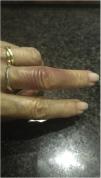A 55-year-old female nonsmoker, who had no past history of interest and was not undergoing treatment, was seen for recurrent, painful, bluish-violet lesions that initially developed more than 10 years earlier and would suddenly and spontaneously appear on the palms and fingers, subsequently disappearing within 4–5 days. The patient did not associate the lesions with either cold or trauma.
Physical ExaminationPhysical examination revealed macules of varying sizes, some bluish with an ecchymotic appearance, on the dorsal aspect of a finger and on the palm of the hand (Figs. 1 and 2). Hand temperature was normal and arterial pulses were present.
Additional TestsThe results of a laboratory work up, including a complete blood count, coagulation parameters, thrombophilia testing, autoimmunity markers, cryoglobulins, a proteinogram, lupus anticoagulant, and serology, were normal. Capillaroscopy findings were nonspecific and the results of an arterial Doppler study of the supra-aortic trunks were normal.
[[?]]What is Your Diagnosis?DiagnosisParoxysmal finger hematoma or Achenbach syndrome.
Treatment and EvolutionThe patient underwent follow-up without receiving any treatment.
DiscussionAchenbach syndrome or paroxysmal hematoma of the fingers is a rare disorder of unknown etiology that causes sudden, painful edema in one or more fingers, associated with bluish or hematoma-like discoloration. This condition follows a benign course, is generally self-limiting (resolving within 3–4 days), and may be caused by underlying capillary fragility.1 It is usually spontaneous or caused by minimal trauma, and has occasionally been associated with other disorders such as acrocyanosis, gastrointestinal or biliary diseases, and migraine.2 It is more prevalent in women and individuals aged approximately 50 years.
Diagnosis is based on the exclusion of other potentially more serious diseases. A laboratory work up should be performed, including coagulation parameters, a thrombophilia study, immunological tests, a proteinogram, and analysis of autoimmunity markers. Results of imaging tests such as arterial Doppler ultrasound, arteriography, and radiography are normal; skin biopsy findings are normal or inconclusive; and capillaroscopy reveals neither hemorrhages nor other alterations in capillary morphology or blood flow.
Korzadeh3 and Brown4 have proposed different diagnostic algorithms for patients who present bluish discoloration on one or more fingers, as outlined below:
- •
Acute arterial ischemia: older men, smokers, absent pulses.
- •
Thromboangiitis obliterans (Buerger disease): young male smokers, superficial thrombophlebitis, Raynaud syndrome, cold sensitivity. Typical arteriography.
- •
Raynaud syndrome: young age, color change from white to blue when exposed to cold, chronic and recurrent episodes.
- •
Acrocyanosis: childhood onset, pale hands, exacerbation in cold environments. There are also forms secondary to paraneoplastic, autoimmune, drug-induced, and neurological processes.
- •
Perniosis: pain, edema, pallor, itching, and even ulceration in acral areas during colder months.
- •
Other cold-induced disorders: cryoglobulinemia, cryofibrinogenemia.
- •
Gardner-Diamond syndrome: individuals with psychiatric disorders, affects any part of the body, accompanied by vagal symptoms and bleeding.
- •
Digital vein thrombosis: bluish nodule, less painful, situated over interphalangeal joint. Rare in women.
- •
Coagulation disorders, antiphospholipid syndrome.
- •
Vasculitis: palpable purpura, livedo reticularis, nodules.
- •
Other: calciphylaxis, cholesterol emboli, warfarin necrosis.
In conclusion, we describe a case of Achenbach syndrome, which although infrequent should be included within the diagnostic algorithm for blue discoloration of the fingers, and diagnosed by exclusion given the absence of any alterations in additional tests.
Conflicts of InterestThe authors declare that they have no conflicts of interest.








